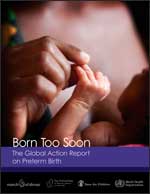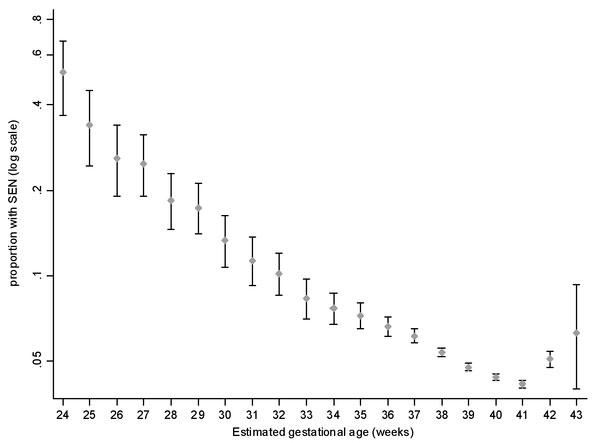Birth - Preterm: Difference between revisions
| Line 19: | Line 19: | ||
* '''Patterns and outcomes of preterm hospital admissions during pregnancy in NSW, 2001-2008'''<ref name="PMID22409693"><pubmed>22409693</pubmed>| [https://www.mja.com.au/journal/2012/196/4/patterns-and-outcomes-preterm-hospital-admissions-during-pregnancy-nsw-2001-2008 Med J Aust]</ref> "Preterm hospital admission affects one in six women with singleton pregnancies. Methods that could improve assessment of labour status have a large potential to reduce the burden on maternity services. The increased morbidity for infants born after maternal transfer suggests women with high-risk pregnancies are being appropriately identified." | * '''Patterns and outcomes of preterm hospital admissions during pregnancy in NSW, 2001-2008'''<ref name="PMID22409693"><pubmed>22409693</pubmed>| [https://www.mja.com.au/journal/2012/196/4/patterns-and-outcomes-preterm-hospital-admissions-during-pregnancy-nsw-2001-2008 Med J Aust]</ref> "Preterm hospital admission affects one in six women with singleton pregnancies. Methods that could improve assessment of labour status have a large potential to reduce the burden on maternity services. The increased morbidity for infants born after maternal transfer suggests women with high-risk pregnancies are being appropriately identified." | ||
* '''Preterm birth and reduced birthweight in first and second teenage pregnancies: a register-based cohort study'''<ref name="PMID20618921"><pubmed>20618921</pubmed></ref> "The risk of preterm birth was increased in first and second time mothers aged 14-17 yrs compared to the reference group. Birthweight was reduced in the first and second time mothers aged 14-17 yrs compared to the reference group. There was some evidence of a protective effect against VSGA in 14-17 yr old first time mothers." | * '''Preterm birth and reduced birthweight in first and second teenage pregnancies: a register-based cohort study'''<ref name="PMID20618921"><pubmed>20618921</pubmed></ref> "The risk of preterm birth was increased in first and second time mothers aged 14-17 yrs compared to the reference group. Birthweight was reduced in the first and second time mothers aged 14-17 yrs compared to the reference group. There was some evidence of a protective effect against VSGA in 14-17 yr old first time mothers." | ||
* '''Overweight and obesity in mothers and risk of preterm birth and low birth weight infants'''<ref name="PMID20647282"><pubmed>20647282</pubmed>| [http://www.bmj.com/cgi/content/full/341/jul20_1/c3428 BMJ]</ref> "Overweight and obese women have increased risks of preterm birth and induced preterm birth and, after accounting for publication bias, appeared to have increased risks of preterm birth overall. The beneficial effects of maternal overweight and obesity on low birth weight were greater in developing countries and disappeared after accounting for publication bias." | * '''Overweight and obesity in mothers and risk of preterm birth and low birth weight infants'''<ref name="PMID20647282"><pubmed>20647282</pubmed>| [http://www.bmj.com/cgi/content/full/341/jul20_1/c3428 BMJ]</ref> "Overweight and obese women have increased risks of preterm birth and induced preterm birth and, after accounting for publication bias, appeared to have increased risks of preterm birth overall. The beneficial effects of maternal overweight and obesity on low birth weight were greater in developing countries and disappeared after accounting for publication bias." | ||
* '''Differing prevalence and diversity of bacterial species in fetal membranes from very preterm and term labor'''<ref name="PMID19997613"><pubmed>19997613</pubmed></ref> "Intrauterine infection may play a role in preterm delivery due to spontaneous preterm labor (PTL) and preterm prolonged rupture of membranes (PPROM). Because bacteria previously associated with preterm delivery are often difficult to culture, a molecular biology approach was used to identify bacterial DNA in placenta and fetal membranes. ...A greater spread and diversity of bacterial species were found in tissues of women who had very preterm births. It is unclear to what extent the greater bacterial prevalence observed in all vaginal delivery groups reflects bacterial contamination or colonization of membranes during labor. Bacteria positive preterm tissues are associated with histological chorioamnionitis and a pronounced maternal immune paresis." | * '''Differing prevalence and diversity of bacterial species in fetal membranes from very preterm and term labor'''<ref name="PMID19997613"><pubmed>19997613</pubmed></ref> "Intrauterine infection may play a role in preterm delivery due to spontaneous preterm labor (PTL) and preterm prolonged rupture of membranes (PPROM). Because bacteria previously associated with preterm delivery are often difficult to culture, a molecular biology approach was used to identify bacterial DNA in placenta and fetal membranes. ...A greater spread and diversity of bacterial species were found in tissues of women who had very preterm births. It is unclear to what extent the greater bacterial prevalence observed in all vaginal delivery groups reflects bacterial contamination or colonization of membranes during labor. Bacteria positive preterm tissues are associated with histological chorioamnionitis and a pronounced maternal immune paresis." | ||
Revision as of 13:09, 7 June 2012
| Educational Use Only - Embryology is an educational resource for learning concepts in embryological development, no clinical information is provided and content should not be used for any other purpose. |
Introduction
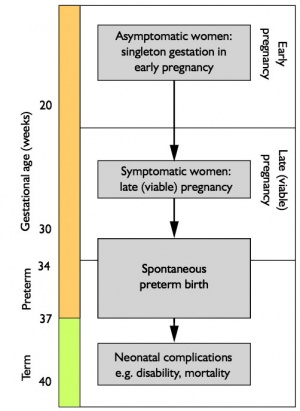
Preterm delivery (PTD) is defined as birth before 37 completed weeks of gestation (GA). In the USA the preterm birth rate declined in 2008 to 12.3 percent, from 12.8 percent in 2006. The preterm birth rates also declined from 2006 to 2008 for mothers of all age groups under age 40.[2] Very premature infants have associated clinical problems that may include: neonatal respiratory distress syndrome, bronchopulmonary dysplasia, cerebroventricular haemorrhage and a range of brain pathologies.
- In the United States, more than 30,000 babies per year are born before the 28th week of pregnancy.
Some Recent Findings
|
Recent References | References
Premature Birth
| Year | < 34 weeks % | 34-36 weeks % | total preterm % |
| 1990 | 3.3 | 7.3 | 10.6 |
| 1995 | 3.3 | 7.7 | 11 |
| 2000 | 3.4 | 8.2 | 11.6 |
| 2005 | 3.6 | 9.1 | 12.7 |
Data from: Prevention of preterm birth: a renewed national priority Damus K. Curr Opin Obstet Gynecol. 2008 Dec;20(6):590-6 PMID: 18989136
Growth Chart for Preterm Babies
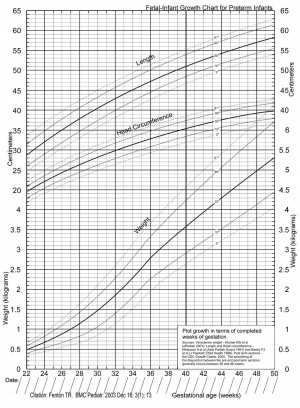
- 1976 - the Babson and Benda "fetal-infant growth graph" for preterm infants was commonly used in neonatal intensive care.[9]
- 1996 - the Beeby graph based upon New South Wales Midwives Data Collection (MDC) from 1990 to 1994 inclusive (n = 422139).[10]
- 1999 - the National Institute of Child Health and Human Development Neonatal Research Network (NICHD) USA graph.[11]
- 2003 - improved version of the Babson and Benda graph based upon literature review and intrauterine data.[8]
Australia Preterm Birth
Patterns and outcomes of preterm hospital admissions during pregnancy in NSW, 2001-2008[4]
NSW is the largest by population of all Australian states (7,238,819 or 32.4% 2010 estimate). The following information is from the abstract of the above paper published in March 2012.
- Women who were admitted to hospital in weeks 20-36 of pregnancy (preterm) and gave birth to a liveborn singleton infant in New South Wales during 2001-2008. Numbers of preterm admissions of pregnant women who were discharged without giving birth, were transferred to higher care, or who gave birth.
- 110 439 pregnancies (16.0%) involved at least one preterm admission. After their initial preterm admission:
- 71.9% of women were discharged.
- 6.3% were transferred.
- 21.8% gave birth.
- Median gestational age at admission was 33 weeks and median time to discharge, transfer or giving birth was 1 day.
- Of the women who were admitted or were transferred with suspected preterm labour, only 29% and 38%, respectively, gave birth.
- As gestational age increased, the proportion of women transferred decreased and the proportion giving birth increased.
USA Preterm Birth
Late preterm birth[12]"The American College of Obstetricians and Gynecologists suggests that preterm birth rates have also increased because of a dramatic rise in late preterm births, defined as births between 34 weeks and 36-6/7 weeks of gestation. Late preterm newborns are the fastest growing subset of neonates, accounting for approximately 74% of all preterm births and about 8% of total births."
USA Preterm Birth Rate
Preterm birth rates per 100 births in each specified gestational age category.
| Total preterm | Extremely preterm | Early preterm | Late preterm |
| less than 37 weeks’ gestation | less than 28 weeks’ gestation | less than 34 weeks’ gestation | 34–36 weeks’ gestation |
| 12.7 | 0.8 | 3.6 | 9.0 |
- Data: USA Preterm birth rates national Vital Statistics System, United States, 2007.
- Links: USA Statistics
Ultrasound Short Cervix
Evaluation of the cervical morphology and biometry with transvaginal ultrasonography at 16-24 weeks of gestation is a useful tool to predict the risk of preterm birth in low- and high-risk singleton pregnancies. The following points are from a recent review on transvaginal sonography for both the prediction and management of spontaneous preterm labour.[13]
Cervical Length (CV)
- > 30 mm - present cervical gland area have a 96-97% negative predictive value for preterm delivery at <37 weeks.
- ≤25 mm - irrespective of other risk factors, use of progesterone.
- ≤ 25 mm - asymptomatic cervical shortening with prior spontaneous preterm delivery, prophylactic cerclage procedure should be performed.
Neural Development
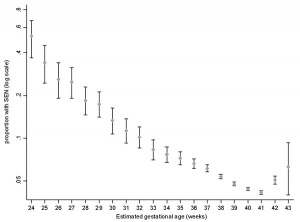
A recent UK population-based study[14] "These findings show that gestational age at delivery strongly affects a child's subsequent risk of having an special educational need (SEN) in a dose-dependent manner across the whole range of gestational age. Furthermore, because early term delivery is much more common than preterm delivery, these findings show that early term delivery is responsible for more cases of SEN than preterm delivery."
Maternal Obesity
The following text information is from a recent systematic review and meta-analyses of maternal obesity[6]
What is already known on this topic
- The effect of overweight or obesity in women on risk of preterm birth is debated in the literature
- Uncertainty is reflected in national guidelines, although it is widely believed that the risk of having an infant of low birth weight is decreased in overweight or obese women
What this study adds
- Overweight or obese women have increased risks of preterm birth before 32 weeks and induced preterm birth before 37 weeks, and, accounting for publication bias, preterm birth before 37 weeks overall
- The beneficial effects of overweight or obesity on low birth weight were greater in developing than developed countries and disappeared after accounting for publication bias
- Overweight and obese women should be counselled before pregnancy on their perinatal risks, and appropriate surveillance should be considered during pregnancy
Inhaled Nitric Oxide Therapy
NIH Consensus Development Conference (2010) conclusions
- Taken as a whole, the available evidence does not support use of inhaled nitric oxide in early routine, early rescue, or later rescue regimens in the care of premature infants <34 weeks gestation who require respiratory support.
- There are rare clinical situations, including pulmonary hypertension or hypoplasia, that have been inadequately studied in which inhaled nitric oxide may have benefit in infants <34 weeks gestation. In such situations, clinicians should communicate with families regarding the current evidence on its risks and benefits as well as remaining uncertainties.
- Basic research and animal studies have contributed to important understandings of inhaled nitric oxide benefits on lung development and function in infants at high risk of bronchopulmonary dysplasia. These promising results have only partly been realized in clinical trials of inhaled nitric oxide treatment in premature infants. Future research should seek to understand this gap.
- Predefined subgroup and post hoc analyses of previous trials showing potential benefit of inhaled nitric oxide have generated hypotheses for future research for clinical trials. Prior strategies shown to be ineffective are discouraged unless new evidence emerges. The positive results of one multicenter trial, which was characterized by later timing, higher dose, and longer duration of treatment, require confirmation. Future trials should attempt to quantify the individual effects of each of these treatment-related variables (timing, dose, and duration), ideally by randomizing them separately.
- Based on assessment of currently available data, hospitals, clinicians, and the pharmaceutical industry should avoid marketing inhaled nitric oxide for premature infants <34 weeks gestation.
- Links: NIH Consensus Development Conference: Inhaled Nitric Oxide Therapy for Premature Infants October 27-29, 2010 | draft consensus statement
References
- ↑ 1.0 1.1 <pubmed>19796569</pubmed>
- ↑ NCHS Data Brief Number 39, May 2010
- ↑ <pubmed>22660967</pubmed>
- ↑ 4.0 4.1 <pubmed>22409693</pubmed>| Med J Aust
- ↑ <pubmed>20618921</pubmed>
- ↑ 6.0 6.1 <pubmed>20647282</pubmed>| BMJ
- ↑ <pubmed>19997613</pubmed>
- ↑ 8.0 8.1 <pubmed>14678563</pubmed>| BMC Pediatr.
- ↑ <pubmed>978333</pubmed>
- ↑ <pubmed>9007782</pubmed>
- ↑ <pubmed>10429008</pubmed>
- ↑ <pubmed>20508778</pubmed>
- ↑ <pubmed>22523687</pubmed>| J Pregnancy
- ↑ 14.0 14.1 <pubmed>20543995</pubmed>| PLoS Medicine
Articles
<pubmed>22505945</pubmed>
Search Pubmed
July 2010 "Preterm Birth" All (31665) Review (3598) Free Full Text (4781)
Search Pubmed: Preterm Birth
External Links
External Links Notice - The dynamic nature of the internet may mean that some of these listed links may no longer function. If the link no longer works search the web with the link text or name. Links to any external commercial sites are provided for information purposes only and should never be considered an endorsement. UNSW Embryology is provided as an educational resource with no clinical information or commercial affiliation.
- The Partnership (PMNCH) - joins the maternal, newborn and child health (MNCH) communities into an alliance of more than 350 members to ensure that all women, infants and children not only remain healthy, but thrive. Born Too Soon: The Global Action Report on Preterm Birth
Glossary Links
- Glossary: A | B | C | D | E | F | G | H | I | J | K | L | M | N | O | P | Q | R | S | T | U | V | W | X | Y | Z | Numbers | Symbols | Term Link
Cite this page: Hill, M.A. (2024, April 27) Embryology Birth - Preterm. Retrieved from https://embryology.med.unsw.edu.au/embryology/index.php/Birth_-_Preterm
- © Dr Mark Hill 2024, UNSW Embryology ISBN: 978 0 7334 2609 4 - UNSW CRICOS Provider Code No. 00098G
